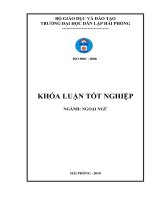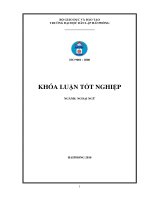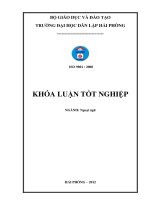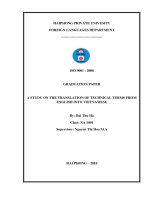A translation of english sport - related terms into vietnamese
Bạn đang xem bản rút gọn của tài liệu. Xem và tải ngay bản đầy đủ của tài liệu tại đây (1.51 MB, 90 trang )
1
Haiphong private university
Department of foreign language
o0o
Graduation paper
A translation of english sport-related
terms into vietnamese
By :
ng« viÖt tuÊn
Class :
na903
Supervisor :
nguyÔn thÞ phi nga, m.a
haiphong - june 2009
2
Bộ giáo dục và đào tạo
Tr-ờng đại học dân lập hảI phòng
.o0o .
Nhiệm vụ đề tài tốt nghiệp
Sinh viên. Mã Số
Lớp Ngành.
Tên đề tài.
.
3
Nhiệm vụ đề tài
1. Nội dung và các yêu cầu cần giải quyết trong nhiệm vụ đề tài tốt nghiệp ( về
lý luận, thực tiễn, các số liệu cần tính toán và các bản vẽ ).
2. Các số liệu cần thiết để thiết kế, tính toán.
3. Địa điểm thực tập.
4
cán bộ h-ớng dẫn đề tài tốt nghiệp
Ng-ời h-ớng dẫn thứ nhất
Họ và tên :
Học hàm, học vị :
Cơ quan công tác :
Nội dung h-ớng dẫn :
Ng-ời h-ớng dẫn thứ hai
Họ và tên :
Học hàm, học vị :
Cơ quan công tác :
Nội dung h-ớng dẫn :
Đề tài tốt nghiệp đ-ợc giao ngày tháng năm 2009
Yêu cầu phải hoàn thành tr-ớc ngày tháng năm 2009
Đã nhận nhiệm vụ Đ.T.T.N Đã giao nhiệm vụ Đ.T.T.N
Sinh viên Cán bộ h-ớng dẫn
Hải Phòng, ngày tháng năm 2009
Hiệu tr-ởng
GS.TS.NGƯT. Trần Hữu Nghị
5
Phần nhận xét tóm tắt của cán bộ h-ớng dẫn
1. Tinh thần thái độ của sinh viên trong quá trình làm đề tài tốt nghiệp.
2. Đánh giá chất l-ợng của Đ.T.T.N ( so với nội dung yêu cầu đã đề ra trong
nhiệm vụ Đ.T.T.N trên các mặt lý luận, thực tiễn, tính toán giá trị sử dụng, chất
l-ợng các bản vẽ ).
3. Cho điểm của cán bộ h-ớng dẫn :
( Điểm ghi bằng số và chữ )
Hải Phòng, ngày tháng năm 2009
Cán bộ h-ớng dẫn chính
( Họ tên và chữ kí )
6
Nhận xét đánh giá
của ng-ời chấm phản biện đề tài tốt nghiệp
1. Đánh giá chất l-ợng đề tài tốt nghiệp về các mặt thu thập và phân tích số liệu
ban đầu, cơ sở lý luận chọn ph-ơng án tối -u, cách tính toán chất l-ợng thuyết
minh và bản vẽ, giá trị lý luận và thực tiễn của đề tài.
2. Cho điểm của ng-ời chấm phản biện :
( Điểm ghi bằng số và chữ )
Ngày tháng năm 2009
Ng-ời chấm phản biện
7
Acknowledgement
During the process of doing this graduation paper, I have received many
necessary assistances, previous ideas and timely encouragements from my
teachers, family and friends.
First of all, I wish to express my deepest gratitude to my supervisor ‟ Mrs
Nguyen Thi Phi Nga, MA of Foreign Language Department, who has always
been willing to give me valuable advices and suggestions in order that I can
complete successfully this study.
My sincere thanks are also sent to the teachers in the English Department of
HaiPhong Private University for their useful lessons and whole-hearted advices
during four years studying here.
Last but not least, I would like to give heartfelt thanks to my family, friends
and the journalists of “Vnexpress” e-newspaper, who I never have enough words
to express my great gratitude for all their helps, encouragements and supports.
HaiPhong, June 2009
Student
Ngo Viet Tuan
8
Table of contents
Part I : Introduction
1. Rationale 1
2. Research restriction and application 1
3. Research method 2
Part II : Development
Chapter I : Theoretical Background.
1. TRANSLATION.
1.1_ Concepts of Translation and Equivalence in translation 3
1.1.1_Concepts of translation 3
1.1.2_ Concepts of equivalence in translation 6
1.2_ Types of translation 6
1.3_ Types of equivalence 9
2. ESP in translation.
2.1_ Concept of ESP 10
2.2_ Types of ESP 11
3. Languages in sport.
9
Chapter II : A translation of English sport-terms relating to
football, tennis and athletics into Vietnamese.
1. TYPICAL Terms relating to Football.
1.1_ Factors to occur a professional football match 14
1.1.1_ Football field 14
1.1.2_ Football Players and Position of them in equivalence with formation 17
1.1.3_ The other factors 23
1.2_ The situations in a football match 25
1.3_ Skills in Football 32
1.3.1_ The positions to touch ball 32
1.3.2_ Basic skills 33
1.3.3_ Complicated skills 39
1.4_ Strategies in football 44
2. TYPICAL Terms relating to tennis.
2.1_ The main tournaments and the way to score in Tennis 46
2.1.1_ The main tournaments in ITF system 46
2.1.2_ The way to score in Tennis 52
2.2_ Tennis court 55
2.3_ Skills in Tennis 57
2.4_ The other terms in Tennis 62
3. TYPICAL Terms relating to Athletics.
3.1_ The events in Athletics 64
3.2_ The other terms in Athletics 69
10
Chapter III : Findings.
Part III : Conclusion
Reference
Glossary
11
PART I : Introduction
1_ Rationale
Sport was “born” as soon as the Man appeared on the Earth. Regardless of the
historical fluctuation, in the process of the existence, Sport still remains an
important role in the human life. Sport brings many extraordinary things back to
us. It is not only a good health, joy, happiness or the relaxation after a hard-
working day but also, above all, the man-to-man connection as well as the peace
for the mankind. I’ll be always etched with a documentary film, I have ever seen,
telling about the greatness of sport: In a far Africa country drowning on the
chaotic Civil War, the soldiers and the civilians were still naive, eager and happy
to participate in the football match in the street like the close friends. At that
time, I wondered “Is there anything more wonderful than that in the world ?”
Along with the trend of the mankind development, Sport also has been moving
on the firm steps and, day by day, confirming how deep its influence on the daily
life is. Even in Vietnam_ a country integrating in the world of sport so late but
Sport quickly gets more and more familiar to Vietnamese, especially after
Vietnam hosts Seagames 22
nd
in 2003. However, a problem obstructing the
spread of sport in Vietnam is really the plenty of the sports followed by the
complication of the sport terms which confuses everyone. This motivates me_ a
crazy fan of sport _to willingly do one thing to break this hinder and bring sport
closer to everyone. For this reason, I chose this topic for my graduation.
2_ Research restriction and application
During the time of my research, I have met with many sport terms. It actually
benefits me in life and probably contributes to my decision on the career in the
12
future. Due to the limitation of timeframe and knowledge, in this graduation
paper, I only can introduce the English-Vietnamese terms of three favourite
sports in the world nowadays: Football _the King sport, Tennis and Athletics _
both in the share with the title of the Queen sport. Besides, some terms of the
other sports will be displayed in the Glossary.
My research can be valuable for teachers and students of Foreign Language
Department in particular and the fans of sport of the other departments at HPU in
general. Moreover, it may be also an useful reference document for the
newspapers and Haiphong Broadcasting and Television.
3_ Research method.
To successfully complete this topic, I’m patient and enthusiastic :
- To ask my supervisor, friends and the reporters for advice.
- To collect documents and the sources of information such as on Internet,
TV, references books, newspapers etc
- To base on my experiences on sport.
13
PART II : DEVELOPMENT
CHAPTER I : THEORETICAL BACKGROUND
1_ TRANSLATION.
1.1_ Concepts of Translation and Equivalence in translation.
1.1.1_Concepts of translation.
There are many concepts of translation all over the world. Following is some
typical concepts :
Translation is the interpreting of the meaning of a text and the
subsequent production of an equivalent text, likewise called a
"translation," that communicates the same message in another language.
The text to be translated is called the "source text," and the language that
it is to be translated into is called the "target language"; the final product
is sometimes called the "target text."
_Wikipedia_
Translation is the process of changing something that is written or
spoken into another language.
_Advanced Oxford Dictionary_
14
Translation is a bilingual mediated process of communication which
ordinarily aims at the production of a TL text that is functionally
equivalent to a SL text.
_Reiss, 1971:161_
Translation is the replacement of text material of this language (source
language) with text material of another ( target language).
_Cartford, 1965 : 20_
Translation is the process of finding a Target language equivalent for a
Source language utterance.
_Pinhhuck, 1977 : 38_
Translation is a transfer process, which aims at the transformation of a
written SL text into an optimally equivalent TL text, and which requires
the syntactic, the semantic and the pragmatic understanding and analytical
processing of the SL.
_ Wilss (1982: 3)_
Translation consists of reproducing in the receptor language the closest
natural equivalent of the source language message, first in terms of
meaning and secondly in terms of style.
_Nida (1984:83)_
15
Translation involves the transfer of meaning from a text in one language
into a text in another language.
_ Bell (1991:8)_
Translation is a process of communication whose objective is to import
the knowledge of the original to the foreign reader.
_Levy (1967:148)_
Translation is the act of transferring through which the content of a text
is transferred from the SL into the TL.
_ Foster (1958:1)_
Translation is to be understood as the process whereby a message
expressed in a specific source language is linguistically transformed in
order to be understood by readers of the target language"
_ Houbert (1998:1)_
Translation is an act of communication which attempts to relay, across
cultural and linguistic boundaries, another act of communication.
_ Hatim and Mason (1997:1)_
Translation is a text with qualities of equivalence to a prior text in
another language, such that the new text is taken as a substitute for the
original.
_ David Frank (Wordpress.com)_
16
1.1.2_ Concepts of equivalence in translation.
Equivalence-oriented translation is a procedure which replicates the same
situation as in the original, whilst using completely different wording.
_Vinay and Darbelnet_
Translation equivalence exists between forms in a source language and a
target language if their meaning matches. In other words, translation
equivalence should answer the question “What do the speakers of this
language actually say to express the desired meaning?”
_Wayne Leman (Wordpress.com)_
Equivalence, when applied to the issue of translation, is an abstract
concept and actually refers to the equivalence relationship between the
source text and the target text.
_Asian social science(CCSE)_
1.2_ Types of translation.
Translation can be divided into 8 types as below :
1.2.1_ Word-to-word translation:
This is often demonstrated as interlinear translation, with the TL immediately
below the SL words. The SL word-order is preserved and the words translated
singly by their most common meaning, out of context.
EG : Peter is the teacher living and working in Manchester.
Peter lµ mét gi¸o viªn ®ang sèng vµ lµm viÖc ë Manchester.
17
1.2.2_ Literal translation:
The SL grammatical construction is converted to the nearest TL equivalents but
the lexical words are again translated singly, out of context.
EG : My brother put all his whole year - savings in this game.
Anh trai tôi đã đặt tất cả số tiền dành dụm đ-ợc cả năm trời của mình vào
trò chơi đó.
1.2.3_ Faithful translation:
A faithful translation attempts to reproduce the precise contextual meaning of
the original within the constraints of the TL grammatical structures.
EG : So many men, so many minds.
Lắm thầy nhiều ma.
1.2.4_ Semantic translation:
Semantic translation differs from faithful translation only in as far as it must take
more account of the aesthetic value of the SL text, compromising on meaning
where appropriate so that no assonance, word-play or repetition jars in finished
version.
EG : So many men, so many minds.
Làm dâu trăm họ.
1.2.5_ Free translation :
Free translation reproduces the matter without the manner, or the content with
out of the form of the original. The advantage of this type of translation is that
the text in TL sounds more natural. On the contrary, the disadvantage is that
translating is too casual to understand the original because of its freedom.
18
EG : The silent road to the small village evanesces in the weak sunshine of
the twilight.
Con đ-ờng vắng lặng đìu hiu dẫn tới ngôi làng nhỏ mờ ảo trong ánh
chạng vạng của hoàng hôn.
1.2.6_ Adaption :
This is the freest form of translation. It is used mainly for plays and themes
The SL culture is converted into the TL culture and is rewritten.
EG : It would rather the victorious brightness in an only moment
than the centenary twinkle.
Thà một phút huy hoàng rồi vụt tắt
Còn hơn buồn le lói suốt trăm năm
<Xuân Diệu>
1.2.7_ Idiomatic translation :
Idiomatic translation reproduces the message of the original but tends to
distort nuances of meaning by preferring colloquialisms and the idiom where
these do not exists in the original.
EG : Love me, love my dog.
Yêu nhau yêu cả đ-ờng đi
Ghét nhau ghét cả tông ti họ hàng.
1.2.8_ Communicative translation:
Communicative translation attempts to reader the exact contextual meaning of
the original in such a way that both content and language are readily acceptable
and comprehensible to the readership.
19
EG : Hello ! How are you ?
L©u l¾m kh«ng gÆp ! CËu d¹o nµy sao råi ?
1.3_ Types of equivalence
Baker explores the notion of equivalence at different levels, in relation to the
translation process, including all different aspects of translation and hence
putting together the linguistic and the communicative approach. She
distinguishes :
Equivalence that can appear at word level and above word level,
when translating from one language into another. Baker acknowledges
that, in a bottom-up approach to translation, equivalence at word level is
the first element to be taken into consideration by the translator. In fact,
when the translator starts analyzing the ST s/he looks at the words as
single units in order to find a direct 'equivalent' term in the TL. Baker
gives a definition of the term word since it should be remembered that a
single word can sometimes be assigned different meanings in different
languages and might be regarded as being a more complex unit or
morpheme. This means that the translator should pay attention to a
number of factors when considering a single word, such as number,
gender and tense.
Grammatical equivalence, when referring to the diversity of
grammatical categories across languages. She notes that grammatical rules
may vary across languages and this may pose some problems in terms of
finding a direct correspondence in the TL. In fact, she claims that different
grammatical structures in the SL and TL may cause remarkable changes in
the way the information or message is carried across. These changes may
induce the translator either to add or to omit information in the TT
because of the lack of particular grammatical devices in the TL itself.
Amongst these grammatical devices which might cause problems in
20
translation Baker focuses on number, tense and aspects, voice, person and
gender.
Textual equivalence, when referring to the equivalence between a SL text
and a TL text in terms of information and cohesion. Texture is a very
important feature in translation since it provides useful guidelines for the
comprehension and analysis of the ST which can help the translator in his
or her attempt to produce a cohesive and coherent text for the TC audience
in a specific context. It is up to the translator to decide whether or not to
maintain the cohesive ties as well as the coherence of the SL text. His or
her decision will be guided by three main factors, that is, the target
audience, the purpose of the translation and the text type.
Pragmatic equivalence, when referring to implicatures and strategies of
avoidance during the translation process. Implicature is not about what is
explicitly said but what is implied. Therefore, the translator needs to work
out implied meanings in translation in order to get the ST message across.
The role of the translator is to recreate the author's intention in another
culture in such a way that enables the TC reader to understand it clearly.
2_ ESP in translation
2.1_ Concept of ESP:
- ESP is the abbreviation for English for Specific Purpose. It is defined in the
other ways. Some people described ESP as simply being the teaching of English
for any purpose that could be specified. Others, however, were more precise,
describing it as the teaching of English used in academic studies or the teaching
of English for vocational or professional purposes.
- Tony Dudley-Evans, co-editor of the ESP Journal gives an extended definition
of ESP in terms of 'absolute' and 'variable' characteristics (see below).
Definition of ESP (Dudley-Evans, 1997)
21
Absolute Characteristics
1. ESP is defined to meet specific needs of the learners
2. ESP makes use of underlying methodology and activities of the discipline it
serves.
3. ESP is centered on the language appropriate to these activities in terms of
grammar, lexis, register, study skills, discourse and genre.
Variable Characteristics
1. ESP may be related to or designed for specific disciplines
2. ESP may use, in specific teaching situations, a different methodology from
that of General English
3. ESP is likely to be designed for adult learners, either at a tertiary level
institution or in a professional work situation. It could, however, be for learners
at secondary school level
4. ESP is generally designed for intermediate or advanced students.
5. Most ESP courses assume some basic knowledge of the language systems
2.2_ Types of ESP:
David Carter (1983) identifies three types of ESP:
„ English as a restricted language
„ English for Academic and Occupational Purposes
„ English with specific topics.
- The language used by air traffic controllers or by waiters are examples of
English as a restricted language. Mackay and Mountford (1978) clearly illustrate
the difference between restricted language and language with this statement: “
the language of international air-traffic control could be regarded as 'special', in
the sense that the repertoire required by the controller is strictly limited and can
be accurately determined situationally, as might be the linguistic needs of a
dining-room waiter or air-hostess. However, such restricted repertoires are not
languages, just as a tourist phrase book is not grammar. Knowing a restricted
22
'language' would not allow the speaker to communicate effectively in novel
situation, or in contexts outside the vocational environment (pp. 4-5).
- The second type of ESP identified by Carter (1983) is English for Academic
and Occupational Purposes. In the 'Tree of ELT' (Hutchinson & Waters, 1987),
ESP is broken down into three branches:
a) English for Science and Technology (EST)
b) English for Business and Economics (EBE)
c) English for Social Studies (ESS)
Each of these subject areas is further divided into two branches:
+ English for Academic Purposes (EAP)
+ English for Occupational Purposes(EOP).
An example of EOP for the EST branch is 'English for Technicians' whereas an
example of EAP for the EST branch is 'English for Medical Studies'.
- The third and final type of ESP identified by Carter (1983) is English with
specific topics. Carter notes that it is only here where emphasis shifts from
purpose to topic. This type of ESP is uniquely concerned with anticipated future
English needs of, for example, scientists requiring English for postgraduate
reading studies, attending conferences or working in foreign institutions.
According to the types of ESP above, Sport lies in English for Social Studies
(ESS).
3_ Languages in sport:
Language in sport can be divided into 2 types as following:
3.1_ Spoken English in sport (Live commentary).
- With the requirement of quickness and understandability for listeners,
especially listeners who only go with the match with radio, live commentary
23
usually only uses popular sport terms such as free-kick, throw-in, corner-kick
etc and restricts complex and difficult terms, sport slangs. The use of the
complex followed by the explanation of commentator may be a good way but it
can raise a question that listeners neglect or omit some situations of the match.
3.2_ Review in sport.
- Unlike live commentary, sport review assesses and analyses the match in
comprehension. A good review must come into the depth and pro. It involves
much more terms relating that sport to animates the review. The complex and
difficult terms and sport slangs accompanied by the explanations need using at
maximum because it is the way to bring sport terms closer to everyone. And
when these are popular, live commentary can use them in no hesitance.
24
CHAPTER II : A TRANSLATION OF ENGLISH
SPORT-TERMS RELATING TO football, tennis
and athletics into VIETNAMESE.
1_ TYPICAL Terms relating to
Football.
1.1_ Factors to occur a professional football match.
1.1.1_ Football field.
GOAL: “CÇu m«n” hay “Khung thành” VÀ “Bµn th¾ng” (in
Vietnamese)
There are two definitions: The metal or wooden structure which is at the center
of each end line & for adult play is 8 yards wide & 8 feet high; also, a "goal" is
scored when the ball totally crosses the end line inside the goal.
A GOAL includes :
CROSSBAR / BAR : “Xµ ngang” (In Vietnamese)
POST : “Cét däc” (in Vietnamese)
Penalty box: “Khu cÊm ®Þa” (in Vietnamese)
The large box in front of the goal in which the goalkeeper can touch the ball with
hands Size will vary by age group & club rules. On adult sized fields, the
Penalty Box extends 18 yards from the Goal Line into the field.
25
Penalty box arc: “Vßng trßn cÊm ®Þa” (in Vietnamese)
The half circle at the top of Penalty box.
Penalty (kick) mark: “ChÊm ph¹t ®Òn” hay “ChÊm 11m”
(in Vietnamese)
The "Penalty Mark" is a mark on the field from which a Penalty Kick is taken. It
is 12 yards out from the Goal for U-12 & older and less for U-8 & U-10.
Goal box: “Khu vùc cÇu m«n” (in Vietnamese)
End-line/goal-line: “§êng biªn ngang” (in Vietnamese)
The lines that define the ends of the field.
Side-line/touch-line: “§êng biªn däc” (in Vietnamese)
The long sides of the field.
Center circle: “Vßng trßn trung t©m” (in Vietnamese)
Circle in the center of the field; usually 6 yard radius for U-8, 8 yard radius for
U-10 & 10 yard radius for U-12 & older. On a kick off, defenders must stay
outside this until the ball is moved by the kicker.
Halfway-line: “V¹ch gi÷a s©n” (in Vietnamese)
The line across the middle of the length of the field that splits it into two halves.
Corner arc: “Vßng ph¹t gãc” (in Vietnamese)
The small arc at each corner of the field for corner kick.









